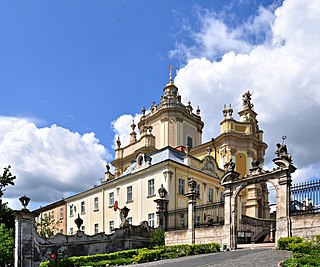
The Ukrainian Greek Catholic Church (UGCC) is a major archiepiscopal sui iuris ("autonomous") Eastern Catholic church that is based in Ukraine. As a particular church of the Catholic Church, it is in full communion with the Holy See. It is the third-largest particular church in the Catholic Church after the Latin Church and the Syro-Malabar Church. The major archbishop presides over the entire Church but is not distinguished with the patriarchal title. The incumbent Major Archbishop is Sviatoslav Shevchuk.

Lubaczów is a town in southeastern Poland, close to the border with Ukraine, with 12,567 inhabitants Situated in the Subcarpathian Voivodeship, it is the capital of Lubaczów County and is located 50 kilometres northeast of Przemyśl.

Bila Tserkva is a city in central Ukraine. It is situated on the Ros River in the historical region of right-bank Ukraine. It is the largest city in Kyiv Oblast and serves as the administrative centre of Bila Tserkva Raion and Bila Tserkva urban hromada, and has a population of 207,273., 205,000.

The Polish Autocephalous Orthodox Church, commonly known as the Polish Orthodox Church, or Orthodox Church of Poland, is one of the autocephalous Eastern Orthodox churches in full communion. The church was established in 1924, to accommodate Orthodox Christians of Polish descent in the eastern part of the country, when Poland regained its independence after the First World War.

St Andrew's Church is an Orthodox church in Kyiv, constructed between 1747 and 1754 to a design by the Italian architect Bartolomeo Rastrelli. It is a rare example of Elizabethan Baroque in Ukraine. Situated on a steep hill, where Andrew the Apostle is believed to have foretold the great future of the place as the cradle of Christianity in the Slavic lands, the church overlooks the historic Podil neighborhood.

Buchach is a city located on the Strypa River in Chortkiv Raion of Ternopil Oblast (province) of Western Ukraine. It hosts the administration of Buchach urban hromada, one of the hromadas of Ukraine. Buchach rests 135 kilometres south-east of Lviv, in the historic region of Halychyna (Galicia). The city was located in the Polish–Lithuanian Commonwealth until the partitions, followed by the Habsburg monarchy (1772–1804), Austrian Empire (1804–1867), Austria-Hungary (1867–1918), West Ukrainian People's Republic (1918–1919), the Second Polish Republic (1919–1939), and the Ukrainian SSR of the Soviet Union (1939–1991). The population was estimated at 12,171.
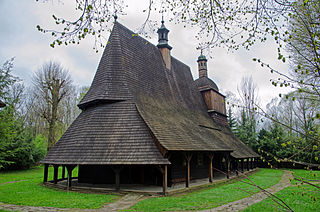
The wooden churches of southern Lesser Poland of the UNESCO inscription are located in Binarowa, Blizne, Dębno, Haczów, Lipnica Murowana, and Sękowa. There are in fact many others of the region which fit the description: "The wooden churches of southern Little Poland represent outstanding examples of the different aspects of medieval church-building traditions in Roman Catholic culture. Built using the horizontal log technique, common in eastern and northern Europe since the Middle Ages..."

Skalat is a small city in Ternopil Raion, Ternopil Oblast, western Ukraine. It hosts the administration of Skalat urban hromada, one of the hromadas of Ukraine. Population: 3,739.
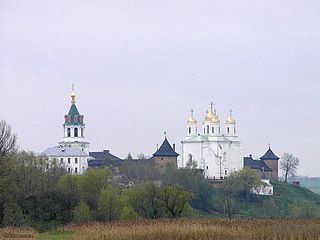
The Assumption Monastery at the Holy Mountain is a stauropegial Ukrainian Orthodox cave monastery belonging to the Ukrainian Orthodox Church. It is located at the top of the Holy Mountain rising above the Luha River near the village of Zymne. It is five kilometers south of Volodymyr, Volyn Oblast, Ukraine.

Komańcza is a village in the Sanok County, in the Subcarpathian Voivodeship (province) of south-eastern Poland. It is situated in the Bukowsko Upland mountains, located near the towns of Medzilaborce and Palota.

The Church of the Transfiguration in Lviv, Ukraine is located in the city's Old Town, just north of the market square.

Wooden church architecture in Ukraine dates from the beginning of Christianity in the area and comprises a set of unique styles and forms specific to many sub-regions of the country. As a form of vernacular culture, construction of the churches in specific styles is passed on to subsequent generations. The architectural styles vary from very simple to complicated, involving a highly skilled carpentry and exceptional artistry in wood-cutting.

The Wooden Tserkvas of the Carpathian Region in Poland and Ukraine are a group of wooden Orthodox churches located in Poland and Ukraine which were inscribed in 2013 on the UNESCO World Heritage List which explains:
built of horizontal wooden logs between the 16th and 19th centuries by communities of Orthodox and Greek Catholic faiths. The tserkvas bear testimony to a distinct building tradition rooted in Orthodox ecclesiastic design interwoven with elements of local tradition, and symbolic references to their communities’ cosmogony. — World Heritage Centre
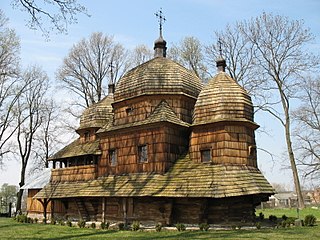
Mother of God Church in Chotyniec is a Gothic wooden church located in the village of Chotyniec from the seventeenth-century, which together with different tserkvas is designated as part of the UNESCO Wooden tserkvas of the Carpathian region in Poland and Ukraine.
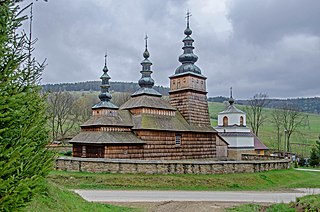
Protection of Our Most Holy Lady Church in Owczary is a Gothic, wooden church located in the village of Owczary from the seventeenth century, which together with different tserkvas is designated as part of the UNESCO Wooden tserkvas of the Carpathian region in Poland and Ukraine.
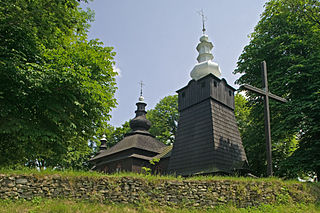
St. Michael Archangel's Church in Brunary is a Gothic, wooden church located in the village of Brunary from the eighteenth-century, which together with different tserkvas is designated as part of the UNESCO Wooden tserkvas of the Carpathian region in Poland and Ukraine.

St. Michael Archangel's Church in Turzańsk is a nineteenth-century wooden church located in the village of Turzańsk. Along with various other tserkvas, it is designated as part of the UNESCO Wooden tserkvas of the Carpathian region in Poland and Ukraine.

St. Paraskevi Church in Kwiatoń - a Gothic, wooden church located in the village of Kwiatoń from the nineteenth-century, which together with different tserkvas is designated as part of the UNESCO Wooden tserkvas of the Carpathian region in Poland and Ukraine.

St. Paraskevi Church in Radruż is a Gothic, wooden church from the sixteenth-century located in the village of Radruż, Poland, which together with different tserkvas is designated as part of the UNESCO Wooden tserkvas of the Carpathian region in Poland and Ukraine.
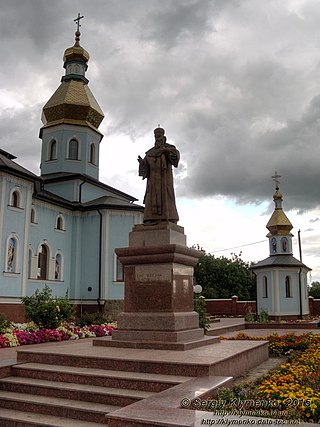
Kovalivka is a village of Bila Tserkva Raion, Kyiv Oblast, Ukraine. It hosts the administration of Kovalivka rural hromada, one of the hromadas of Ukraine. The village is administered by its own rural council. The population is approximately 1,500.




















